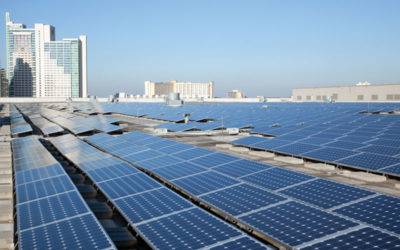Winter and Summer in the Northern Hemisphere
You may wonder why your solar panels yield different amounts of energy at different times of the year. It might be confusing why one year they produced the most power in, let’s say, June, and the next year they peaked in a different month. Variations in solar intake occur due to the ever-changing weather we experience on Earth. Some of the changes appear in predictable patterns, such as the path the Earth travels, while other changes appear unpredictably, such as how many cloudy days there will be in a month.
The Earth is Tilted

https://ashwinnarayan.blogspot.com/2009/12/tilt-of-earths-axis.html
In addition to the path on which the Earth and the other planets orbit around the Sun, the Earth also spins on its own on an axis of rotation. This axis is an imaginary line through the center of the Earth and tilts at an angle of 23.5°.
As the Earth spins, the tilt causes different parts of the Earth to lean closer to the Sun at different times.
Summer occurs in June, July, and August because that is the time when the Earth is tilted the most toward the Sun, causing its rays to hit more directly. In the same way, winter occurs in December, January, and February because that is the time of year when the Earth is tilted the least toward the Sun, causing its rays to hit more indirectly.
The movement of the Earth around the Sun also causes the days to be longer in the summer and shorter in the winter. Solar panels collect more energy in the summer, because that’s when the Sun shines on them for the longest amount of time. Conversely, they collect less energy in the winter.
Unpredictable Weather
 Sometimes on a day in June, when your solar panels should theoretically be the highest yielding, you might not collect a lot of energy. This might occur because the day is cloudy; clouds can block sunlight from reaching your solar panels. If a month features an exceptionally high rate of cloudy days, you might yield less solar power than expected during that month. This is due to our Earth’s crazy weather. Unlike the Earth’s path, which goes through the exact same cycle every year, it’s hard to predict if days will be cloudy or sunny. Even meteorologists, who make a career out of studying the weather, can’t always predict what the sky will look like. The phrase “June Gloom” reminds us that although June is at the beginning of summer, because June can be filled with cloudy days, it might not yield as much solar power as you’d expect.
Sometimes on a day in June, when your solar panels should theoretically be the highest yielding, you might not collect a lot of energy. This might occur because the day is cloudy; clouds can block sunlight from reaching your solar panels. If a month features an exceptionally high rate of cloudy days, you might yield less solar power than expected during that month. This is due to our Earth’s crazy weather. Unlike the Earth’s path, which goes through the exact same cycle every year, it’s hard to predict if days will be cloudy or sunny. Even meteorologists, who make a career out of studying the weather, can’t always predict what the sky will look like. The phrase “June Gloom” reminds us that although June is at the beginning of summer, because June can be filled with cloudy days, it might not yield as much solar power as you’d expect.
Sample of How Much Energy Solar Panels Can Yield Throughout the Year
This annual comparison from sunnyportal.com shows a sample of how much energy solar panels tend to yield throughout the year. The solar panels at this Aikyum customer’s home have been collecting clean energy since May 2014.
Total yield [kWh]
| January | February | March | April | May | June | July | August | September | October | November | December | Total | |
| 2014 | 771.60 | 1271.35 | 1173.85 | 1230.26 | 1024.10 | 824.89 | 756.49 | 594.54 | 7647.08 | ||||
| 2015 | 680.82 | 810.91 | 1091.93 | 1117.13 | 983.68 | 1117.29 | 1086.02 | 1139.56 | 1006.43 | 843.96 | 792.43 | 691.10 | 11361.25 |
| 2016 | 581.99 | 913.53 | 1047.21 | 1118.86 | 1022.38 | 1120.98 | 1233.83 | 727.83 | 7766.61 | ||||
| 26774.94 | |||||||||||||
| Mean value | 631.41 | 862.22 | 1069.57 | 1118.00 | 1003.03 | 1169.87 | 1164.57 | 1184.91 | 1015.26 | 834.43 | 774.46 | 642.82 | 11470.53 |
| Year
portion |
5.50% | 7.52% | 9.32% | 9.75% | 8.74% | 10.20% | 10.15% | 10.33% | 8.85% | 7.27% | 6.75% | 5.60% | 100.00% |
As you can see, June, July, and August produced the highest energy yield, at 10.20%, 10.15%, and 10.33%, respectively, of the total annual yield, for an average of 10.22% per month. On the other hand, November, December, and January yielded the least energy, with December at 5.60% and January at 5.50%. The winter month of February, however, yielded 7.52% of the annual energy, higher than the 6.75% produced by November, a fall month. This demonstrates weather’s unpredictability. Generally, though, you can plan for your solar panels to follow the trend of collecting more energy in the summer and less energy in the winter, with spring and fall somewhere in between.
Contact Aikyum Solar today for a FREE Quote and take advantage of your opportunity to install solar panels.





